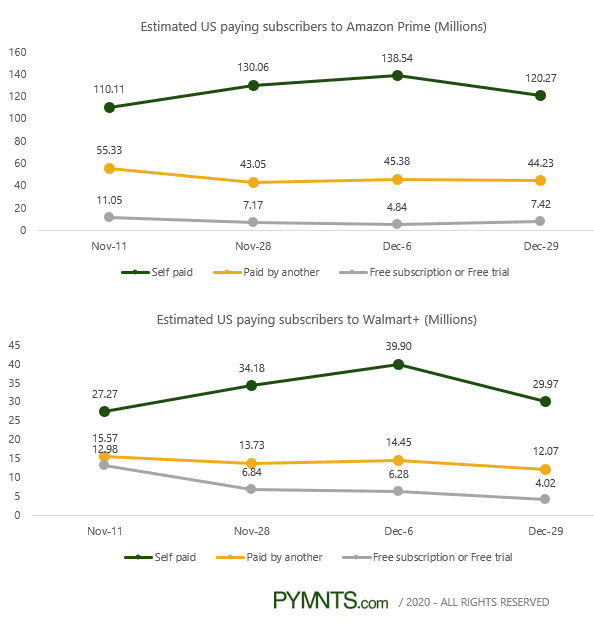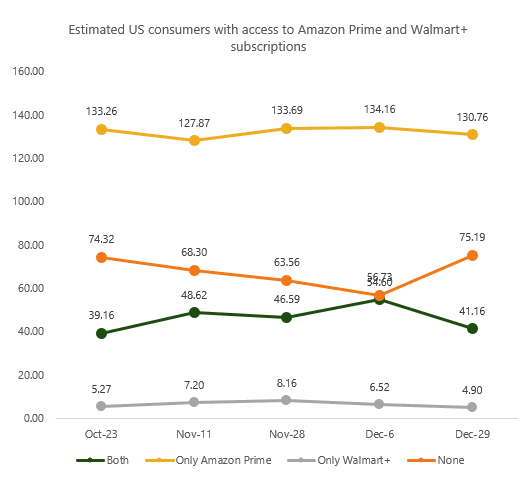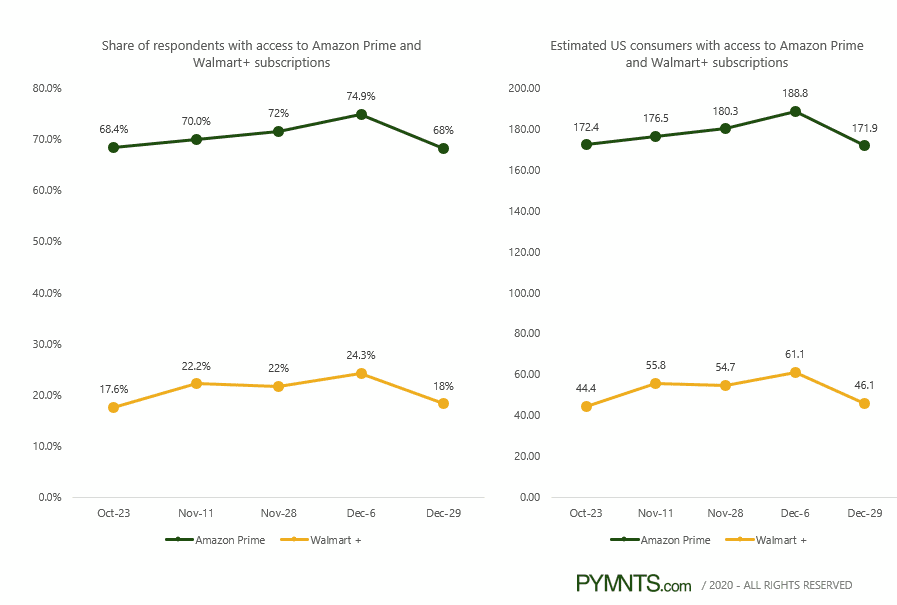
Amazon Prime and the recently launched Walmart+ both saw drop-offs in U.S. paid subscribers in late December, but Walmart+ fell further — showing the newcomer has a fight on its hands to win broad adoption.
A PYMNTS survey of U.S. consumers found that Walmart+ paid subscriptions (rather than free trials or subscriptions paid by someone else) fell to 29.97 million as of Dec. 29, down 24.9 percent from Dec. 6’s 39.9 million. That’s steeper than the 13.2 percent decline seen at Amazon Prime, where paid subscriptions fell to 120.27 million on Dec. 29 from 138.54 million as of Dec. 6:

Walmart+ saw a similar drop-off even when including consumers who were either on free trials or had subscriptions paid by someone else. PYMNTS found that those fell to 46.1 million Americans as of Dec. 29, down 24.5 percent from 61.1 million just 23 days earlier.
Amazon Plus’ total subscribers (paid, free trial or paid by someone else) also fell, but only dropped 9 percent to 171.9 million on Dec. 29 vs. 188.8 million on Dec. 6:

Amazon Prime membership also continues to enjoy far wider adoption as a percentage basis of all American consumers. PYMNTS found that as of Dec. 29, 68 percent of Americans had an Amazon Prime membership vs. just 18 percent for Walmart+.
That’s down for both companies from the Dec. 6 reading, where 74.9 percent of all Americans had Amazon Prime membership vs. 24.3 percent for Walmart+:

However, Walmart+ trailed by 50 percentage points on Dec. 29 vs. 50.6 percentage points on Dec. 6. That’s a small gain at best.
The numbers suggest that Walmart+ — which launched in September — has a long way to go to catch up with rival Amazon Prime, which got more than a 15-year head start by launching in February 2005.
Still, Karen Webster recently wrote that the subscriptions Walmart+ has gotten so far represent “remarkable adoption in such a short period. What everyone, especially Walmart, will be watching intently over the next several months is how many Walmart+ members actually pony up the $98 to convert their free trial to a paid membership — and then how many go on to renew after year one.”
On the plus side, she noted that a PYMNTS survey conducted Oct. 27-28 found some good demographic news for Walmart. For example, the study found that many bridge millennials — a key demographic group — had signed up for both services.
While nearly three times as many bridge millennials were Amazon Prime members rather than Walmart+ members as of Oct. 27-28, Webster noted that 3 in 10 bridge millennials had signed up for both just a month after the Walmart product’s launch.
“Bridge millennials, along with millennials, are part of Amazon Prime’s most loyal customer base,” Webster wrote. “They also comprise the group of consumers that Walmart needs to woo and retain. According to PYMNTS data, 159 percent more bridge millennials and 182 percent more millennials subscribe at Amazon Prime than Walmart+.”
But Webster also noted that Amazon Prime continued as of Oct. 27-28 to enjoy a strong lead over Walmart+ in terms of affluent subscribers. PYMNTS data found that 82 percent of U.S. consumers earning more than $100,000 subscribed to Amazon Prime as of those dates vs. just 22 percent for Walmart+.
PYMNTS’ October survey also found that 85 percent more consumers who subscribe to Walmart+ live paycheck to paycheck and struggle with bills than do Americans who say they pay their expenses comfortably.
Amazon Prime subscribers do far better in that respect. Some 25 percent fewer consumers who subscribe to the service reporting living paycheck to paycheck when compared to Americans who say they can pay bills comfortably.